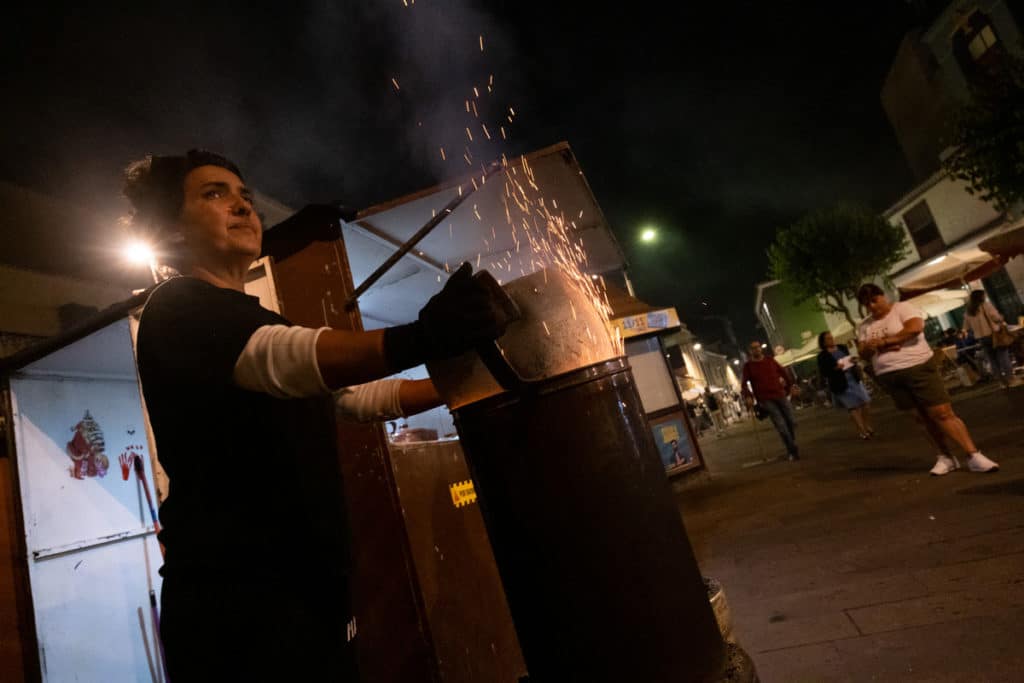
The months of October, November and December of each year positions roasted chestnuts They return to the streets of Tenerife run by a few families that keep the tradition alive. One of those chestnut dynasties is that of Glory Barriera woman that He has been working in chestnut stands for 32 years and currently roasting in the one located next to the Church of La Concepciónin La Laguna: “For us this is more than a trade, it is something that we pass on from generation to generation and that is why we ask that it be recognized as a craft,” he tells DIARIO DE AVISOS.
The first place chestnuts that it got Gloria’s family he rode it his father-in-law in 1950 and was located in the Plaza de España. The good family relationship they have has led them to increase their jobs over time and, currently, they have a ten distributed between Santa Cruz and La Laguna. In the case of Gloria, she started in the Alameda del Duque de Santa Elena, in the capital, and since then, she has not stopped: “Every year we ask for licenses to open during the three months that the chestnut season lasts, which are October, November and December“.
The licenses for the stalls are requested differently in each municipality, says Gloria, who affirms that in La Laguna “we work through the Festival Commissions” and in Santa Cruz “as an Urban Project”. In her opinion, roasted chestnuts “should be part of craft fairs” since the work “is transmitted from generation to generation and the technique is ancient and manual”. In addition, she and other chestnut they usually go to schools, institutes and parties to teach the little ones how that tradition works: “We tell you where the chestnuts are born and how they are harvested”.
For Gloria and her family, the chestnut business is a “relief to count on at the end of each year”. She is housewife and often unemployed “due to how complicated the labor market is”, so at least “the months that we have the jobs we have income and sometimes we even have enough to save”.
By profession, chestnut

Roasting chestnuts is hard work that involves exposure to the high temperatures of the charcoal and the cauldron used for roasting. However, these conditions are not a brake on the many chestnut farmers who dedicate these months to the trade. Gloria jokes that the only drawback to her job is that “our nails are always black,” but Gloria insists that “Women have no qualms about staining ourselves with charcoal”. In fact, count at least four chestnut stalls that are run by women in the metropolitan area: “Those in Plaza de España, Imeldo Serís, Plaza del Adelantado and mine, the one in The conception“.
late season
The precipitations of last September in the Canary Islands were branded as “anomalous” by meteorologists since, due to the proximity of a tropical cyclone to the Archipelago, all rainfall records were broken for that month. The falling water was generally well received by the Tenerife countryside but it did not benefit the chestnut season too much: “Excessive rainfall causes chestnuts to fall from the tree and, once they are on the ground, there is little we can save. Worms always act fast and they enter the fallen chestnuts”, explains Gloria.
Regarding the place of origin, Gloria explains that for nine years the chestnuts have been “averaged” with various farms in the North of Tenerife, which are the ones who mainly supply them. The first chestnuts to come out of the tree are those from La Esperanza, then those from La Victoria, La Matanza and La Orotava. Finally, the ones from Arafo arrive, although these “are somewhat expensive on the market, but they are very good”.















